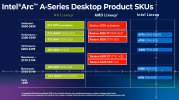DavidGraham
Veteran
So Intel seems to have a very strong Ray Tracing engine indeed, maybe even better than NVIDIA on a theoretical level (Intel Level 4 RT vs NVIDIA Level 3 RT?). On actual games though, that theoretical RT prowess is not shown, Intel is throwing their top of the line A770 against NVIDIA's midrange RTX 3060, a battle which averages out with the A770 being only 14% faster than the 3060 on average, with heavy RT titles showing about 30% advantage for the A770.




